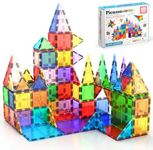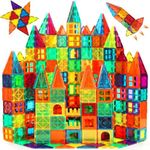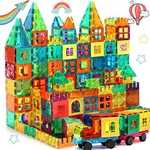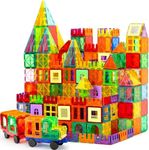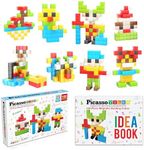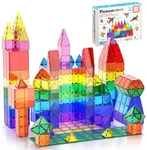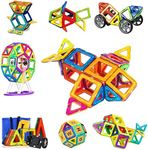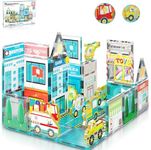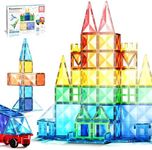Buying Guide for the Best Magnetic Blocks
Magnetic blocks are a popular educational toy that encourage creativity, problem-solving, and fine motor skills in children. When choosing the right set, it's important to consider factors that affect safety, play value, and how well the blocks will suit the age and interests of the child. Understanding the key features will help you select a set that is both enjoyable and appropriate for your needs.Material QualityMaterial quality refers to what the magnetic blocks are made from, usually plastic or wood, and the strength and safety of the magnets inside. High-quality materials are important because they ensure the blocks are durable, safe for children, and free from harmful chemicals. Blocks made from sturdy, non-toxic plastic or wood are less likely to break or chip, which is especially important for younger children who might put toys in their mouths. When choosing, look for sets that mention being BPA-free or meeting safety standards. If the blocks feel solid and the magnets are well-encased, they are likely to last longer and be safer.
Magnet StrengthMagnet strength determines how well the blocks stick together during play. Stronger magnets allow for more complex and stable structures, while weaker magnets might cause frustration if the blocks fall apart easily. For younger children, moderate magnet strength is usually best to avoid pinched fingers, while older kids may enjoy stronger magnets for building larger creations. If you want to build tall or intricate designs, opt for sets known for strong magnets, but always ensure the magnets are securely enclosed to prevent any safety risks.
Block Size and Shape VarietyBlock size and shape variety refers to the different forms and dimensions included in a set, such as squares, triangles, rectangles, or specialty shapes. This is important because a greater variety allows for more creative building and learning opportunities. Larger blocks are easier for small hands to handle and are safer for toddlers, while older children may enjoy smaller or more complex shapes for detailed constructions. Consider the age and skill level of the child: younger kids benefit from basic, larger shapes, while older children can make use of a wider range of pieces.
Set Size (Number of Pieces)Set size is the total number of blocks included. More pieces mean more possibilities for building, but also require more storage space and can be overwhelming for very young children. Small sets are good for beginners or travel, while larger sets are better for group play or advanced builders. Think about how many children will use the set and how elaborate you want the creations to be. If you want to build big structures or play with multiple kids, a larger set is ideal.
Safety FeaturesSafety features include things like rounded edges, secure magnet enclosures, and non-toxic materials. These are crucial, especially for younger children, to prevent injuries or accidental swallowing of small parts. Always check for certifications or safety labels, and avoid sets with small, loose magnets for children under three years old. If safety is your top concern, prioritize sets that clearly state their compliance with recognized safety standards.
CompatibilityCompatibility means whether the blocks can be used with other brands or sets. This is important if you already own magnetic blocks or plan to expand your collection in the future. Compatible sets allow for more creative play and flexibility. If you want to mix and match, check the product details to see if the blocks are the same size and shape as other popular brands.
Educational ValueEducational value refers to how well the blocks support learning, such as teaching colors, shapes, counting, or basic engineering concepts. Some sets include activity guides or cards to inspire building ideas. If you want the blocks to be more than just a toy, look for sets that highlight their educational benefits or come with learning resources. Consider what skills you want to encourage, such as creativity, teamwork, or problem-solving.
